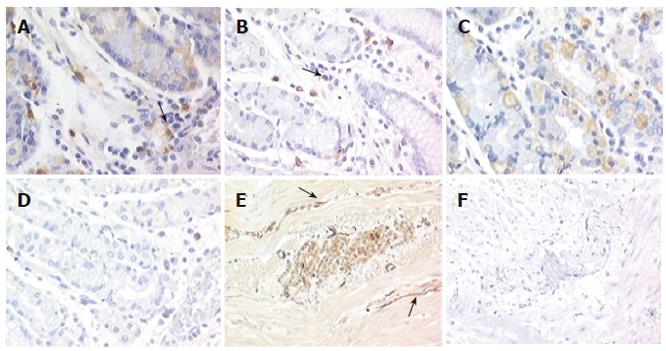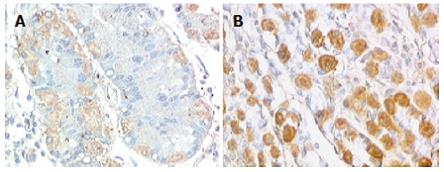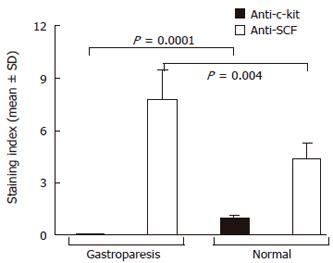INTRODUCTION
Gastroparesis syndrome is a clinical entity characterized by chronic nausea, epigastric discomfort and recurrent vomiting, in the absence of mechanical obstruction[1]. Gastroparesis may be either primary (idiopathic) or secondary, i.e. associated with illnesses or specific disorders that are the likely cause[2]. Apart from common secondary causes of gastroparesis, such as diabetes mellitus and gastric surgery, most cases are idiopathic. Although in recent years some previously-labeled “idiopathic” gastroparesis cases have been shown to have a probable causal relationship with prior viral infections[3] or myoenteric plexus ganglionitis[4], in most cases a definite cause or even a possible link remains undetected.
Indirect evidence from electrogastrographic[5-7] and manometric[8,9] studies suggests that, at least in some patients, gastric hypomotility may be due to alteration of mechanisms controlling the motor activity of the stomach. Interstitial cells of Cajal (ICC), whose importance has been suspected for decades due to their close anatomical relationship with smooth muscle cells and terminal varicosities of enteric nerves[10-12], are the pacemaker cells in the gastrointestinal tract[13-16] and can mediate input from the enteric nervous system[17,18]. It may thus be expected that disruption of ICC networks leads to disordered gastrointestinal motility in the affected segments[19]. Research into ICC biology has been greatly stimulated by the discovery that they express the proto-oncogene c-kit[20,21], and activation of Kit tyrosine kinase receptor signaling by the natural ligand stem cell factor (SCF or steel)[22,23] is necessary for development and maintenance of ICC phenotype[15,24].
Since ICC can express Kit, immunohistochemical analysis using anti-Kit antibodies provides an efficient means of identifying them in a variety of species, including humans[25-27]. In the last few years several reports have demonstrated that ICC abnormalities are associated with some human upper-gut pathological conditions[28,29], although few studies in gastroparetic patients to date are available.
An abnormal reduction of pacemaker cells in the stomach has been recently described in a murine model of gastroparesis[30] and in a case of idiopathic gastroparesis[31]. Here we report a case of severe idiopathic gastroparesis with complete absence of Kit-positive gastric ICC.
MATERIALS AND METHODS
Case history
A 39-year old woman was investigated for a long-lasting complaint of severe dyspeptic symptoms. Her past history included repeated upper GI series and endoscopic examinations, always unremarkable in 1989-1995. She was treated with antacids, sucralfate, clebopride and ranitidine, with little or no success. In 1996 she received our attention for persisting dyspeptic symptoms associated with gastro-esophageal reflux. Physical examination and blood chemistry were unremarkable. An upper panendoscopy showed antral erythema and erosions, and histologic specimens revealed the presence of active gastritis associated with H pylori colonization. After eradication therapy, the patient continued to complain of severe post-prandial discomfort and epigastric fullness, sometimes associated with food regurgitation. Esophageal manometry and pH-metry were normal. Scintigraphic gastric emptying of a 300 kcal standard meal (Tc-albumin labeled egg white)[32] was severely delayed (the t½ at 120 min was 474, normal values 60-150). Abdominal ultrasound scans, small bowel enema and nuclear magnetic resonance of the brain and brainstem were normal. No autonomic dysfunction was documented. Therapeutic courses of high dose cisapride and domperidone were ineffective, as were oral and intravenous erythromycin.
In 1997, since the symptoms continued to worsen with the appearance of vomiting and weight loss, a percutaneous jejunostomy was thus required for feeding. However, in March 2000, due to a poor quality of life, she was again admitted and an upper gastrointestinal manometry[33] showed almost no fasting and post-prandial gastric motility, whereas duodenojejunal motor activity was within normal limits. A total gastrectomy with esophago-jejunal anastomosis and Roux-en-Y reconstruction was carried out. The post-surgical period was uneventful and she was discharged after 10 d. She subsequently enjoyed a good health, regained body weight, and did not complain of abdominal problems at follow-up.
Histology and immunohistochemistry
Multiple full-thickness samples from the stomach (fundus, corpus, and antrum) were obtained at surgery, and processed for conventional histological examination (H&E, Gomori's trichrome) and immunohistochemistry. The myenteric plexuses were assessed with a rabbit polyclonal anti-S-100 antibody (Dako, Carpinteria, CA, USA, dilution 1:4000), a monoclonal anti-CD56 antibody (clone 1B6, Novocastra Laboratories, Newcastle-upon-Tyne, UK, dilution 1:50), a rabbit polyclonal anti-neuron specific enolase (NSE) antibody (Dako, dilution 1:1000), and a monoclonal anti-neurofilament antibody (clone 2F11, Immunon, Shandon, Pittsburgh, PA, prediluted). Expression of Kit and SCF was assessed using a rabbit polyclonal antibody (Dako, dilution 1:50) and a goat polyclonal antiserum produced against a peptide mapping at the amino terminus of SCF of human origin (Santa Cruz Biotechnology, Santa Cruz, CA, dilution 1:100), respectively. Briefly, consecutive formalin-fixed and paraffin-embedded sections were dewaxed and rehydrated through alcohol series up to distilled water. Sections were subjected to heat-induced epitope retrieval (CD56, neurofilaments, Kit and SCF) by immersion in a heat-resistant container filled with citrate buffer solution (pH 6.0) placed in a pressure cooker and micro-waved for 20 min. Endogenous peroxidase activity was suppressed by incubation with 3% solution of H2O2 for 5 min. Immunostaining for CD56, Kit and SCF was done with a peroxidase-based visualization DAKO EnVisionTM kit, following the manufacturer’s recommendations. Immunostaining for S100, NSE, and neurofilaments was performed with a peroxidase-based visualization DAKO LSAB® kit, following the manufacturer’s recommendations. Diaminobenzidine tetrahydrochloride was used as chromogen. The slides were then counterstained with Mayer hematoxylin for 5 s, dehydrated and mounted in Clarion (Biomeda, Foster City, CA, USA).
To determine the non-specific staining, peptides blocking polyclonal antibody binding were used or sections were incubated in the absence of primary antibody. In these cases, no immunostaining was detected. Kit-positive mast cells serving as an internal control, were counted under a light microscope at × 200 magnification within a square micrometer and expressed as mean (SE) per surface area (1 mm2). Quantification of Kit-positive ICC and nervous structures was performed by manual procedures under optical microscope (Carl Zeiss-Axioscop, Germany) and computer-assisted image analysis system (Immagini&Computer, Bareggio, Milano, Italy) using the Image Pro Plus program (Media, Cybernetics, Silver Spring, MD, USA). Five areas (1 mm2) were selected from similar regions in patient and control tissues. The area of immunopositive cells was calculated and expressed as a mean percentage of the total area of the image.
SCF staining patterns were evaluated using the immunoreactive score (IRS) proposed by Remmele[34] in which IRS = staining intensity (SI) × percentage of positive cells (PP). SI was determined as 0 = negative, 1 = weak, 2 = moderate, 3 = strong. PP was defined as 0 = negative, 1 = 1%-20% positive cells, 2 = 21%-50% positive cells, 3 = 51%-100% positive cells. Ten visual fields from different areas of each specimen were chosen at random for IRS evaluation, and the average (SE) was calculated.
Apoptosis detection
Apoptosis was detected by transferase-mediated digoxigenin-tagged 16-desoxy-uridine-triphosphate nick-end labeling (TUNEL) assay, using the DeathEndTM colorimetric TUNEL system (Promega, Madison, WI, USA). After deparaffinization and rehydration, sections were digested with 20 mg/L proteinase K (Sigma, st Louis, MO, USA) for 15 min at room temperature, and then incubated with a terminal transferase plus nucleotide mixture for 1.5 h at 37°C. After exposure to antidigoxigenin peroxidase for 45 min, diaminobenzidine (Sigma) was used as chromogen to detect TUNEL-positive cells, and the sections were counterstained with hematoxylin.
Controls
Control gastric tissue was obtained from 4 specimens of normal stomach taken during pancreasectomy for tumors of the pancreatic head.
Determination of SCF concentrations in sera
Serum samples collected from the patient prior to surgery and 10 age-matched healthy female volunteers, were assayed for soluble SCF using a commercially-available ELISA kit (R&D Systems, Abingdon, UK), following the manufacturer’s instructions. All samples were evaluated in duplicate. The lower threshold of detection of this assay is 9 ng/L.
DISCUSSION
Little is known about the pathogenesis of gastroparesis, and apart from causes secondary to well-known conditions (diabetes mellitus, gastric surgery) only sporadic cases of idiopathic myenteric ganglionitis[4] or infective causes (bacterial, viral) preceding the onset of symptoms have been identified[35,36]. Unfortunately, pathological studies of idiopathic gastroparesis are rare, and the early ones revealed no abnormalities of the smooth muscle or the myenteric plexus[37,38]. More recent evidence (with the introduction of Kit immunodetection) points to a reduction of gastric ICC in idiopathic gastroparesis, both in a murine model[30] and in a single case report[31], although the potential role in this condition of SCF, the critical factor for Kit signaling in ICC[39], has not been investigated.
We report a case of severe gastroparesis refractory to diverse therapeutic measures, which eventually required total gastrectomy to relieve the symptoms, and in which there was complete disruption of the Kit-positive ICC network together with a reduction in number and size of ganglion cells in the submucous and myenteric plexus vs normal counterparts. No signs of apoptosis in the pacemaker and myenteric regions were observed, suggesting that degenerative injuries are not involved in these abnormalities. To the best of our knowledge, a total lack of detectable ICC has never been described in a “functional” gastrointestinal disorder. Since the gastric ICC network is essential for slow wave generation and plays a key role in neurotrasmission of cholinergic excitation and inhibition due to nitric oxyde[17,40], this complete disruption likely explains the significant symptoms, the slow gastric emptying and the lack of response to therapeutic interventions. The lack of detectable Kit-positive ICC may be a primary event or secondary to a loss of connected signaling molecules. Previous studies have shown that ICC can be influenced to abandon the normal course of development, lose pacemaker function, and radically change its morphology if Kit is blocked or if an unsuitable form of SCF is presented[21,41].
The binding of SCF to Kit receptors is essential to initiate a signaling pathway in ICC, which is essential for their normal development and rhythmic activity in the gastrointestinal tract[16,42-45]. We also investigated the expression of SCF in the patient’s mucosa, and found that intracytoplasmatic and membrane SCF levels were particularly high in parietal cells vs controls. In addition, as in the normal counterpart, gastroparesis tissue showed diffuse positivity for SCF throughout the tunica muscularis, potentially in close proximity to ICC.
The steel locus encodes two distinct isoforms of SCF, both of which are synthesized as transmembrane proteins expressed at the cell surface[46]. However, one isoform, known as soluble SCF, is rapidly cleaved by proteolytic processing and released, while the other, known as membrane-bound SCF isoform, lacking the proteolytic cleavage site, releases soluble SCF much more slowly[47,48]. Soluble and membrane-bound isoforms of SCF are expressed in the gastrointestinal tract, but the role of each isoform in supporting ICC development is unknown. However, since spontaneous Steel-Dickie mutant mice that express soluble SCF exclusively do not display spontaneous, rhythmic electric slow wave activity, and ICC are not present in the myenteric plexus[21], membrane-bound SCF more likely plays an essential role in development and/or maintenance of ICC. Since membrane-bound SCF expression was not only retained but even increased in gastric parietal cells and supporting cells potentially in close proximity to ICC in the patient’stissue specimen, we can postulate that in this case of gastroparesis a defective expression of Kit receptor by ICC rather than the absence of these cells leads to accumulation of SCF in this case of gastroparesis. Studies showing that mice harboring inactivating mutations in the c-kit gene lack ICC and their gastrointestinal tract fails to display any slow wave-type action potential[16,24] are in favour of this hypothesis. Since the blocking of Kit receptors in the mouse causes transdifferentiation of ICC to a smooth muscle phenotype[35], this inherent plasticity between ICC and smooth muscle cells might underlie this clinical condition. If verified, this hypothesis might be exploited, because if ICC do not die in gastroparesis but redifferentiate, it might be possible to create conditions that would shift the phenotype back toward ICC.
Besides the increased local accumulation of SCF in this case of gastroparesis, the soluble circulating form estimated by specific ELISA in the serum, was found to be decreased in our patient compared with healthy subjects. This decreased SCF serum concentration is difficult to explain and correlate with the disease, because several cell types, such as stromal cells, fibroblasts and endothelial cells, present in different tissues as well as in the gastrointestinal tract, express and release SCF and may contribute to the circulating soluble form. Moreover, SCF is thought to act locally, close to the site of production, where the concentration is likely to be much higher[49].
This patient has undergone numerous treatments with several different prokinetic drugs, but none of them proved to be effective, as is often the case in this condition[50]. Recently, electrical stimulation of enteric nerves and/or pacing of gastric slow wave activity have been attempted in gastroparesis refractory to medical treatment[51]. Although reports appear to be encouraging (decreased frequency of vomiting and gastrointestinal symptoms, and improved quality of life)[52], it must be kept in mind that this is still to be considered an experimental option available only in a few research centers worldwide. Moreover, it should also take into consideration that, in some cases, pacing the stomach may not be effective in improving emptying when the primary cause of abnormal motility is due to insufficient excitation by the enteric nerves.
The above considerations also leave little room for other therapeutic options, such as injecting botulinum toxin into the pyloric sphincter[53], and a surgical approach may be necessary, and is possible if small bowel function is intact. Only limited data on surgical treatment of gastroparesis are available, showing that complete gastrectomy may be effective for surgical gastroparesis, whereas a more cautious approach is required for the diabetic or idiopathic forms[54].
In conclusion, we report a case of severe idiopathic gastroparesis, which was likely due to impaired gastric motility, the absence of ICC, or more likely due to their functional absence (i.e., ICC were present but not expressing Kit receptors, and therefore not functioning). Since this is the first reported abnormality, these findings may be useful for a better understanding of the pathophysiology of “idiopathic” gastroparesis and perhaps, for a more targeted therapeutic approach. Moreover, there is evidence that enteric abnormalities are also found in other so-called “functional” disorders (such as irritable bowel syndrome)[55], thus leading to a reconsideration of the classification of these entities, in which organic abnormalities are increasingly found.











